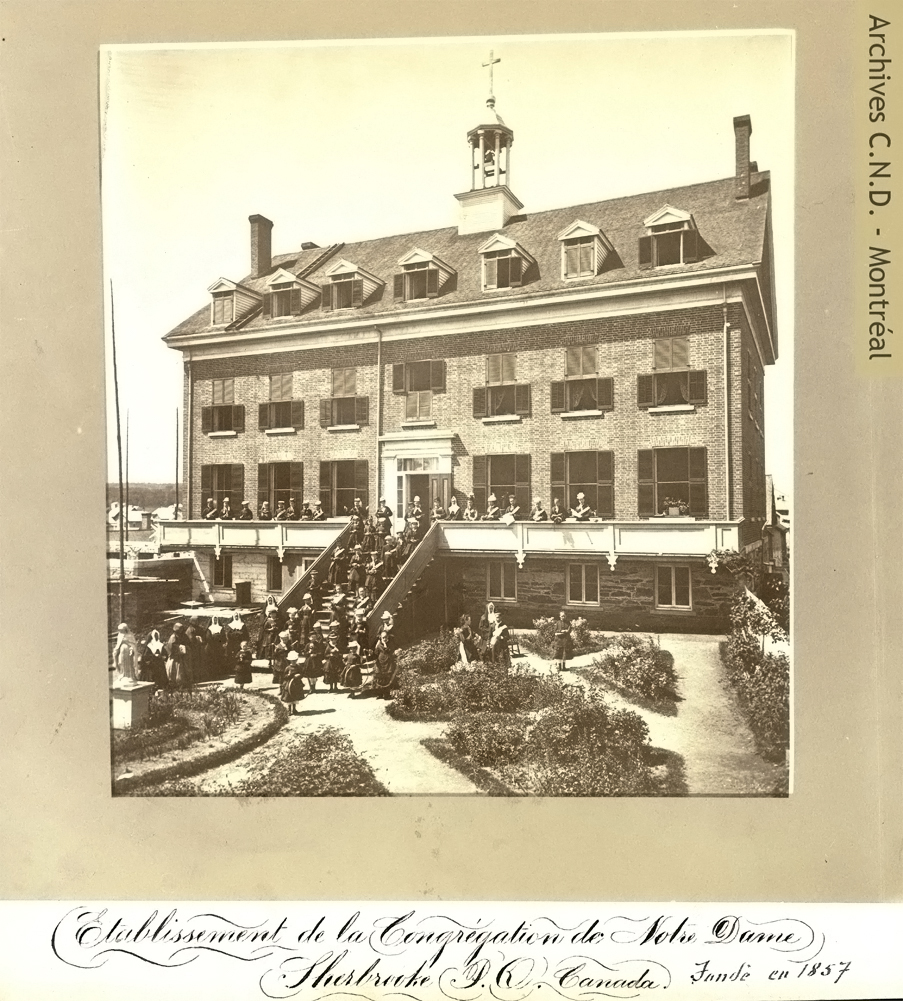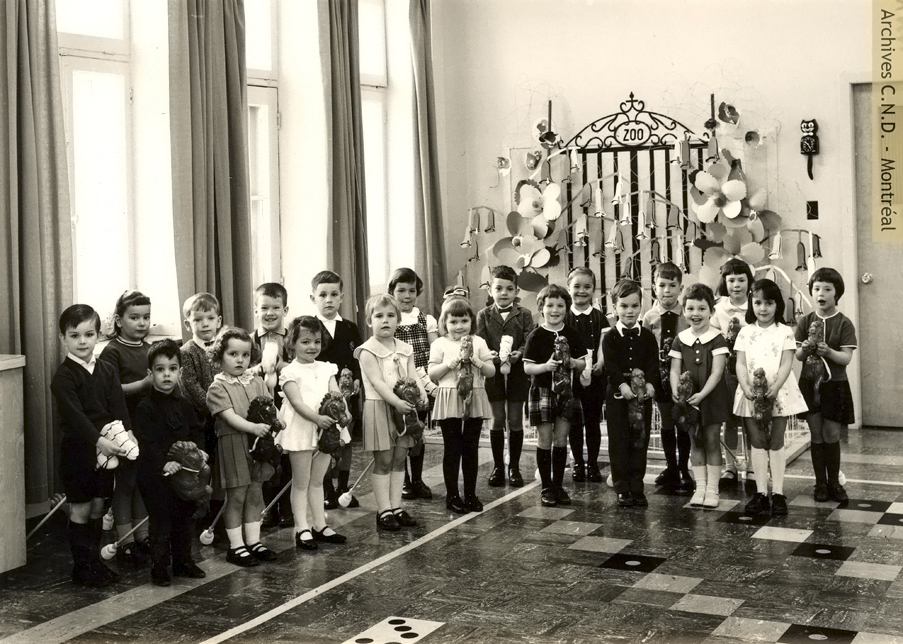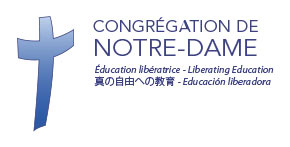Couvent de la Congrégation de Notre-Dame / Mont Notre-Dame
Institution founded in 1857, Sherbrooke, Québec.
The establishment of Mont Notre-Dame de Sherbrooke was the result of the initiative of Mrs. Clara Lloyd Felton, who had wanted the opening of the first Catholic school for girls in the region. In 1850, she launched a fundraising campaign to finance her project. When she first undertook this endeavour, the town was experiencing a population increase. The construction of the St. Lawrence and Atlantic Railroad linked Sherbrooke and Montreal. It was a few more years before the first Catholic bilingual school opened in Sherbrooke. In 1857, Father Alfred-Élie Dufresne, the parish pastor, entrusted the school’s direction to Les Soeurs de la Congrégation de Notre-Dame de Montréal. While waiting for the Congregation sisters to arrive, his sister, Luce Dufresne, taught the convent-school’s very first class. On November 21 of that year, the three founders, Sister Saint-Louis-de-France (Nathalie Lahaye), the superior, Sister Saint-Irénée (Ann-Bridget Phelan) and Sister Saint-Athanase (Louise Drolet), officially opened the school. When they first arrived, the building was only partly furnished and a low enrollment made the first years difficult. The school received weekly boarders and day students, and few fulltime boarders. Nevertheless, in 1857, the sisters opened in the same building another school for elementary level French-and-English-speaking students of the Saint-Michel Parish. Early on, the sisters of the Congrégation de Notre-Dame’s convent-school in Sherbrooke purchased two pianos. At that time, a lay teacher gave singing and piano classes and from the 1860s, art classes were offered. Here, young women students developed their drawing and painting skills. Around 1870, the reputation of the school began to spread both inside and outside the city. More and more young women from the United States, namely Vermont, Maine, New York and even Illinois, enrolled. At that time, six sisters taught approximately two hundred students, divided into five classes. In August 1874, the Diocese of Sherbrooke was established and the Most Reverend Antoine Racine became the city’s first bishop. The following year, he established Saint-Charles-Borromée Seminary (Seminary of Sherbrooke), an all-boys school. For its part, the all-girls boarding school, whose student population was ever-increasing, needed to be enlarged. Consequently, in 1875, an annex was built which doubled the school’s surface area. From 1880, the City of Sherbrooke, which was in full expansion, due to industrialisation, was equipped with an electrical utility. As the city expanded, so did the school. When enrollment doubled, ten sisters received about four hundred young women students, of whom more than sixty were boarders. As the Sherbrooke student population increased, building new schools became imperative. First, district schools opened, and later, more specialized ones. The convent-school’s administration fully understood these new requirements, and many schools were established. In addition to opening Saint-Michel Parish School in 1857, the sisters established Académie Sainte-Marie in 1886, an elementary school for girls located at the intersection of Murray and du Conseil Streets in Sherbrooke’s East district. In 1901, the Congregation sisters opened a co-ed school known as Du Petit-Canada School (later named Notre-Dame-du-Cénacle) in Sherbrooke’s South district, on the corner of Galt and Belvédère Streets. From 1903, the sisters of the Mont commuted daily by streetcar to Lennoxville, where they taught at Saint-Antoine-de-Padoue School. At the same time, before the beginning of the 20th century, the Congrégation de Notre-Dame sisters opened new schools in four other towns in the Eastern Townships: Stanstead (1875), Richmond (1884), Windsor (1886) and Lac-Mégantic (1895). Other than courses in Music and the Arts, the convent-school’s students also were offered classes in Literature, Arithmetic, Home Economics, Geography, History and Diction. From the 1890s, because of its geographical proximity to the Sherbrooke Seminary, male teachers taught Chemistry, Physics, Latin and Philosophy to the young women students. In 1901, the Congrégation de Notre-Dame’s convent-school in Sherbrooke was expanding and new construction was undertaken; hence, a second four-story brick annex was built. The original building was renovated in order to house the new chapel. In 1902, when this work was completed, the school officially took the name Mont Notre-Dame. From that time, thirty-five teaching sisters taught approximately five hundred students. Proud of its now established reputation, the Mont received many prestigious guests through the years. In February 1903, the school welcomed soprano Emma Albani, who performed to the delight of the students. In 1908, the Marguerite-Bourgeoys Study Circle was inaugurated and its members were invited to participate in debates and conferences on such varied subjects as literature and missionary life. In 1914, the students received the visit of Arthur Connaught and Louise-Margareta of Prussia, the Duke and Duchess of Connaught, who were passing through Sherbrooke.
Always committed to their mission, the sisters of Mont Notre-Dame also opened specialized schools in order to fulfill the educational needs of Sherbrooke’s young women. In 1911, the bilingual Business Program was inaugurated. Offered on the Mont’s premises, it ensured the training of young women who were interested in pursuing careers in the business community. Its aim was to allow qualified graduates to earn a living in clerical capacities. In 1915, a School of Housekeeping was also inaugurated. This program was designed particularly for adult women. Later, it was offered in different Congregation schools. In 1918, the Mont became affiliated with the Université de Montréal and thus attained a superior school status. This was a turning point for the young French-speaking women from Sherbrooke who now had access to higher education. For the first time, it was possible for them to take university-level exams. Also, in 1922, after twenty years of negotiating with the Eastern School Board, the Congrégation de Notre-Dame sisters opened a normal school in Sherbrooke for young women who wished to become teachers. It should be mentioned that, from 1880, students of the Mont could take their teaching licence exams at Sherbrooke’s Bureau des examinateurs. When it first opened, Marguerite-Bourgeoys Normal School with its twenty-six enrolled students was housed in Académie Sainte-Marie. After three years, the school moved to the city’s North district, on Ontario Street. When this facility opened, there were seventy-four student teachers enrolled. In the 1920s, the Mont provided education from grade 1 to grade 8. From grade 7, students could choose among several options: Those wanting to go to business school were encouraged to take a transitional course, offered in French and English, to prepare for the business world; it was possible for those opting for the regular program to obtain an elementary or high school level teaching license; those choosing to pursue a graduate course, obtained an Arts and Sciences diploma from the Université de Montréal. In the 1920s, Mont Notre-Dame welcomed within its premises the Congregation’s new Saint-Enfant-Jésus Provincialate. In addition to receiving young women students, it also housed the offices of the new province’s superior and the prefect of studies. The school’s administration continued to modernize and expand its buildings. In 1926, two new wings were built and the original building, which had become obsolete, was demolished. The work was completed in accordance with plans designed by Louis-Napoléon Audet, a well-known architect, who had also created Saint-Michel Cathedral and several religious buildings in Sherbrooke. The students benefited from modern classrooms, a new gymnasium, spacious study rooms and a beautiful Renaissance-style chapel. This chapel later became and, at the time of the publication of this article, still serves as a library. The following year, the playground, facing a beautiful view of the city, was renovated. From the top of the cliff, it offered students a resting area, swing sets and a tennis court. In 1927, the art studio was opened to former students who wished to improve their talents. The artists received various courses such as, Artistic and Industrial Design, Aquarelle, and Oil and Porcelain Painting. In the first half of the 20th century, the sisters of Mont Notre-Dame established several schools in different districts of the city. In 1918, Sainte-Anne School opened in the North district; in 1922, Sainte-Jeanne-d’Arc School (which became Sylvestre School in 1951) on Kitchener Street; in 1927, Sainte-Thérèse-d’Avila School on Victoria Street. From the 1920s, the arrival of new communities of women religious somewhat modified the involvement of the Congrégation de Notre-Dame sisters living in Sherbrooke. Several schools opened. Later, in 1942, the sister sacristans at the Mont, who had worked at Saint-Michel Cathedral for eighty-five years, turned over their ministry to the Little Sisters of the Holy Family. In 1945, the Sisters of Charity of the Sacred Heart of Jesus established Collège Sacré-Cœur, an all-girls classical college. Former Mont Notre-Dame students maintained close ties with their alma mater. In 1921, school graduates formed the Notre-Dame-de-la-Congrégation Alumnae Association. Very active, its members regularly organized musical social teas in order to fund education scholarships. They also participated in school celebrations and commemorations. The Mont students were involved in many religious associations such as, the Enfants de Marie, Légion de Marie, Union de la Sainte-Vierge, Service missionnaire des jeunes, Croisades eucharistiques and Jeunesse étudiante catholique. In March 1937, author Lady Tweedsmuir (Susan Buchan), an active promoter of literature in Canada, visited the Mont’s three hundred thirty students. Also present at this event were representatives of the Catholic Women’s League, Fédération Saint-Jean-Baptiste de Sherbrooke and Ligue de la jeunesse féminine. The young women students also participated in extracurricular activities such as the Ciné-club, which featured a new film every week. Also, in the 1930s, a regional section of the Cercle des jeunes naturalistes (CJN) was opened. During their first year of activity, participants won prizes in botany and mineralogy at the annual exposition in Montreal. Students, teaching sisters and lay teachers were active participants in the City of Sherbrooke’s cultural life. In 1937, the sisters took part in the “made-up” centennial celebrations of the city. Indeed, in an effort to tackle the economic crisis of the time, festivities were launched in grand fashion to celebrate the already 100 year-old city. The celebrations were broadcast on the newly launched CHLT radio station. Quebec Premier Maurice Duplessis, who was passing through Sherbrooke, visited the Mont. Finally, a bronze commemorative plaque honouring the memory of Father Dufresne, the founder of Mont Notre-Dame, was placed on the wall near the cathedral. In 1949, the school celebrated the 90th anniversary of its foundation. For the occasion, the students presented the play Le jeu de la voyagère by Rina Lasnier. At that time, a record number of four hundred twenty-seven students were enrolled at the Mont, of whom one hundred twenty-nine were boarders. The anniversary coincided with the launch of Sherbrooke’s first annual Festival de la jeunesse, whose objective was to encourage young people to study music and theater. The Mont students participated in this event every year. In 1949, the Alumnae Association inaugurated a stained glass in honour of Mrs. Clara Lloyd Felton. A sister who was an art teacher at the Mont did the drawing. For this occasion, the Alumnae Association announced the foundation of the Marguerite-Bourgeoys and Sainte-Anne-d’Auray Scholarships, both funded by former Mont Notre-Dame students. In 1951, the beatification of Marguerite Bourgeoys was celebrated. Students, sisters and lay teachers from all Congregation schools took part in the celebrations held in Sherbrooke’s Cathedral with Bishop Philippe Desranleau presiding. For the occasion, the Eastern Townships’ own poet, Alfred Desrochers, composed Ode à Marguerite Bourgeoys, which was published in La Tribune newspaper. That same year, journalist Jacques Hébert presented numerous travel stories to the student members of the Cercle Marguerite-Bourgeoys. When the Université de Sherbrooke opened in 1954, the Mont Notre-Dame sisters requested affiliation with the University for their courses in Letters and Sciences. In order to expand their professional training, the teachers took courses in Phonetics and Psychology. Two years later, they opened a Domestic Sciences School affiliated with the Université de Sherbrooke. Enrolled students received such varied courses as Inorganic Chemistry, Psychology and Interior Design. This school, housed in Mont Notre-Dame, trained young women to become technicians, nutritionists and professional dieticians. In the 1950s, the walls of Mont Notre-Dame housed elementary-level classes, classical courses, the bilingual Business Course and the Domestic Sciences Program. In 1957, Mont Notre-Dame celebrated its 100th anniversary. Festivities were spread throughout the entire year. First, the English-and-French-speaking students performed a musical entitled Le jeu du centenaire – The Beacon on the Hill in its English version – written by actor Lucie de Vienne Blanc, a Mont Notre-Dame teacher of Diction. The main commemorative activities were held on June 15, 16 and 17, 1957 and Bishop Georges Cabana presided at a Pontifical Mass. Approximately six hundred guests enjoyed an Honours Banquet at the Sherbrooke Fusiliers Armoury on Belvédère Street. The celebrations ended with the 1957 graduation ceremony. In 1958, the all-boys superior school, which Brother Théode (Maxime Lafond), of the Brothers of the Sacred Heart, had opened eight years earlier, on King Street West, moved into a new building on Bowen Street South (At the time of publication, this is the Saint-François Pavilion of the De la Montée School.). The Congrégation de Notre-Dame purchased the vacant building for the students of Saint Mary’s and Saint-Michel Schools. In August 1959, the new school opened and took the name Saint-Michel School. In 1960, the Mont became a high-school-level classical school. The following year, in recognition of the quality of its instruction, the Ministry of Education declared the school of public interest. In an effort to adapt to the evolving educational system, the sisters opened a co-ed kindergarten class in the school. The enrolled pupils, from the ages of three-and-a-half to five, were boarders. In the 1960s and 1970s, boys also attended the elementary levels. In 1962, because of lack of space, the Mont’s English-speaking high-school students and Saint Mary’s elementary students were transferred to Marymount School, a modern building located on Buck Street. In the 1960s, always on the cutting-edge of musical education, the sisters never hesitated to surround themselves with renowned teaching-musicians. Mr. Jean Leduc taught piano, and Mr. Maurice Onderet, Mr. Horace Boux and Mr. Jean Cousineau taught violin. Several methods of musical instruction were used, such as Orff, Ward, Kodály and Corneloup. The parish choir at Mont Notre-Dame was particularly well known. Indeed, year after year, it won various prizes at the Festival de musique du Québec, excelling in religious, Gregorian, profane and folk song. In the 1970s, several services offered in Mont Notre-Dame progressively closed, such as the kindergarten after only nine years. The following year, the Business Program also closed as did, the boarding facility for high-school students in 1974. In 1971, inspired by the Rioux Report, which stemmed from a commission of inquiry on the teaching of the arts in Quebec, the sisters opened an experimental school. In addition to regular courses, girls and boys in the first cycle of elementary school benefited from weekly courses in music, body self-expression and arts and crafts, all taught according to the most pedagogically advanced methods. After the school opened, and for only one year, the School Board opened several other arts classes in Sherbrooke public schools. In 1972, there were about two hundred enrolled students. Experienced teaching sisters helped establish the program in the School Board’s Sacré-Cœur School (Gillespie Street). In 1976, when the Mont numbered six hundred young women students, the Congrégation de Notre-Dame sisters announced their withdrawal from the school after being at its helm for almost one hundred twenty years. The Mont’s institutional succession went to a joint corporation made up of parents, teachers, one sister and representatives of local organizations. It took the name Collège Mont Notre-Dame de Sherbrooke Inc. After the sisters’ permanent departure, one sister continued to teach music until 2001. In 1998, a large fundraising campaign was launched in order to finance the construction of a new gymnasium.
NB: This text was written using documents found in the archival holdings in our possession and does not constitute a complete administrative history of the teaching establishment.
Couvent de la Congrégation de Notre-Dame / Mont Notre-Dame
Couvent de la Congrégation de Notre-Dame / Mont Notre-Dame
Sherbrooke, Quebec
Institution fondée en 1857
Dernière adresse : 114, rue de la Cathédrale
Nom de l’architecte(s) ou de la firme : Louis-Napoléon Audet





